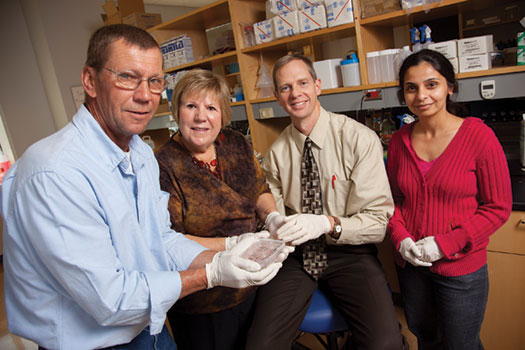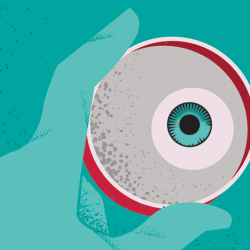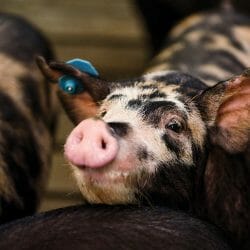A Promising Sight

Siblings Tim Reese and Teri Selzer, at left, provided cell samples to UW researchers David Gamm and Ruchira Singh, at right, who are working to cure an eye disease that runs in the Reese family. Photo: John Maniaci/UW Hospital & Clinics.
They looked like eyelashes and ashes captured in pale orange jello.
But the specks in the Petri dishes were the result of years of research in the laboratory of David Gamm, an ophthalmologist at the UW’s Waisman Center. And as members of the Reese family carefully cradled the dishes, they held the future of their descendants’ eyesight in their hands.
They were seeing cells that were a model of their retinas. The Reese family has Best disease, the second-most common inherited disorder of the macula, the center of the retina. Everyone born into the family has a 50 percent chance of inheriting the gene that slowly destroys their retinas and, thus, their sight.
Two years earlier, Tim Reese, who has the Best gene mutation, and his sister Teri Selzer, who does not, drove to Madison from their homes in northwest suburban Chicago. At the Waisman Center, scientists took a small sample of the skin from their arms with a device that resembles a paper punch. Then Ruchira Singh, the lead researcher on the project, used induced pluripotent stem-cell methods pioneered at the UW to turn the skin cells back into stem cells, and then grew them into retina tissue. Today, Gamm’s technology has advanced so much that his lab can do the same with a blood sample.
The two models allowed the researchers to understand why Reese was slowly losing his vision. They also may yield clues on how to halt or reverse the process. The discovery is one of the most immediate promises of stem cells — creating living laboratory models to understand disease and test treatments.
It’s also another first from the stem-cell laboratory of Gamm, director of the McPherson Eye Research Institute, which is funded by the National Eye Institute and donations from UW alumni and others.
Reese, who began losing his central vision as a child, knows that such cures might come too late for him, but he’s thrilled to help find answers about a disease that blinded his mother and affects younger family members.
“Losing your sight is the slowest death in the world,” he says. “I am doing this for the future. Maybe it won’t help me, but it will help my children and grandchildren.”
Published in the Summer 2013 issue



Comments
No comments posted yet.